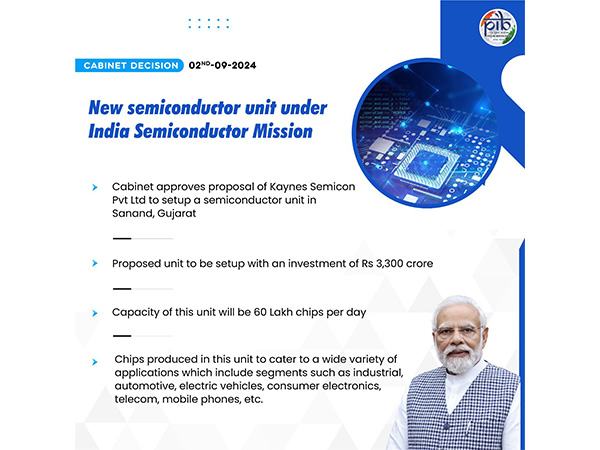India Boosts Semiconductor Ecosystem with New Units in Gujarat and Assam
The Indian government, led by PM Narendra Modi, approved the setup of four semiconductor units in Gujarat and Assam to bolster the country's semiconductor ecosystem. With a significant investment and production capacity, the initiative aims to make India a global power in semiconductor manufacturing.

- Country:
- India
India is taking a substantial leap towards developing a robust semiconductor ecosystem. On Monday, the Union Cabinet, chaired by Prime Minister Narendra Modi, approved Kaynes Semicon Pvt Ltd's proposal to establish a semiconductor unit in Sanand, Gujarat, with an investment of Rs 3,300 crore.
According to an official release, this unit will have a capacity to produce 60 lakh chips daily, serving various sectors such as industrial, automotive, electric vehicles, consumer electronics, telecom, and mobile phones. This follows the announcement of the Programme for Development of Semiconductors and Display Manufacturing Ecosystem in India on December 21, 2021, with a total budget of Rs 76,000 crore. In June 2023, the cabinet had approved a similar setup in Sanand, Gujarat.
In February 2024, approvals were granted for three more semiconductor units: Tata Electronics in Dholera, Gujarat, another in Morigaon, Assam, and CG Power's unit in Sanand, Gujarat. These projects are advancing swiftly, promising an investment of nearly Rs 1.5 lakh crore and a combined capacity of 7 crore chips per day. The Tata Group anticipates the commercial production of semiconductor chips to commence in 2026, highlighting the critical importance of domestic manufacturing for national security and innovation, especially noted during the Covid-19 pandemic.
Currently, work is underway on four semiconductor units—three in Gujarat and one in Assam. Semiconductors, essential for a multitude of modern devices, predominantly come from South Korea, Taiwan, China, the US, and Japan. India aims to start commercial production soon, positioning itself as a significant player in the global semiconductor industry, reminiscent of its roles in technology, nuclear, and digital arenas.
PM Modi, while laying the foundation stones for three semiconductor plants, emphasized India's need to recover lost ground in semiconductor manufacturing. Under the Atmanirbhar Bharat and Make in India initiatives, the government has launched production-linked incentive schemes to make India an attractive hub for global investments, boost exports, integrate into the global supply chain, and reduce reliance on imports.
(With inputs from agencies.)










